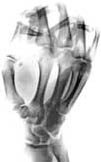
| Records | Reviews | Tracks | Concerts | Gallery |
LifelikeRalf Bei der KellenStaubgold, Oct 2003Staubgold Hans-Joachim Irmler not only owns a cordless phone, but also a mobile! Whenever I talked to him over the last weeks, it seemed that wherever he was, he had a version of Lifelike running in the background - in his house, at friends' houses, in his car (very often), and I suspect that once he even persuaded the owner of a pub to put it on. Why he did this? Certainly not to show off, because he is be nature a shy person. My guess is that he wanted to change the record by listening to it. He has been working for a long time on his first ever solo-outing, which also is - if I'm not greatly mistaken - the first official solo album of any of the original Faust-members ever to be released.
Lifelike was conceived by Irmler as 'a biography in sound' (sounds like the title of a 'Best of James Last' Album, doesn't it? But even that may be part of a plan...). And it's strictly sounds, there are no words in here (at least none discernible). He wanted to describe a person's life through sound. And this is what fAUST have always been good at: to find strange and unusual sounds to trigger their listeners' imagination. This record mirrors the growth of a human being in its microstructure and evolution of life in general in its macrostructure. At the beginning, the listener can hear the sounds of a bubbling primordial soup. Out of this, a simple, innocent theme takes a shy peek. A life is born. Melody evolves out of sound. This peaceful growth soon becomes interrupted by industrial noises (is there a war going on?) - and so we're already into the story after track 2. What Irmler does is the antithesis of so many productions in the field of 'modern electronic music'. Irmler cunningly disturbs simple patterns and shifts them so slightly that at first, it only registers in your subconscious. Thus you are disturbed but you don't know by what. Another point in favour is that this music is nowhere as hectic as many other productions are nowadays with their clicks and beats. This music gives the listener time & space to step inside and if he or she wishes to inhabit this music. From the view of form, Lifelike even resembles classical music with its recurring and interwoven themes. I suggest that - like its creator - you give this music a space to inhabit, to settle down in. This could be your living-room, but it really should be a garden, a forest or a lighthouse. Or let it inhabit your car. And should you happen to stand in front of a level crossing with the lights on red, do not be disturbed if Hans-Joachim Irmler calls you on your mobile. For that's also part of the plan. Best wishes, Ralf Bei der Kellen, "Lifelike", Staubgold 2003ref: Staubgold |
|